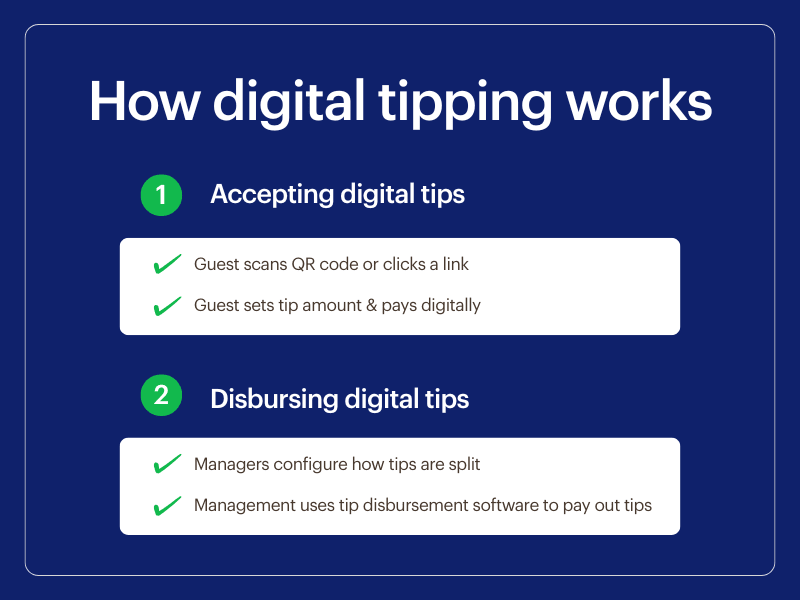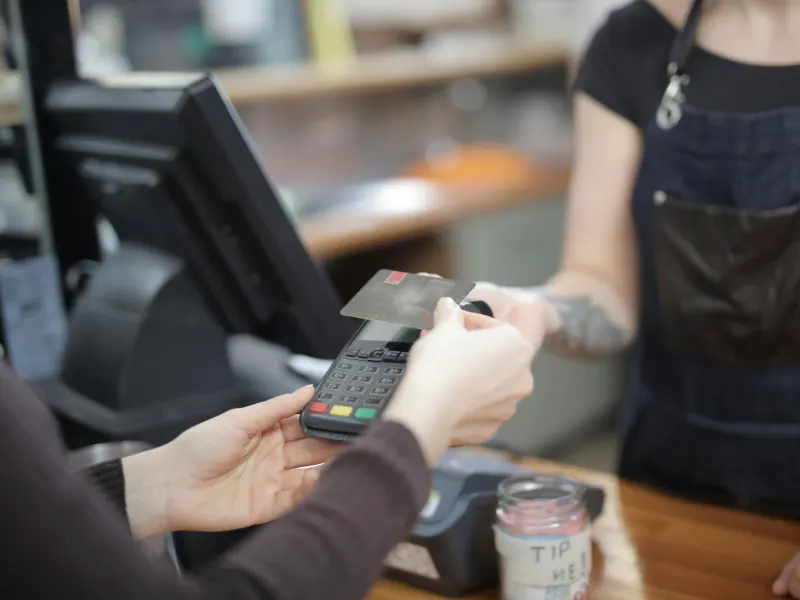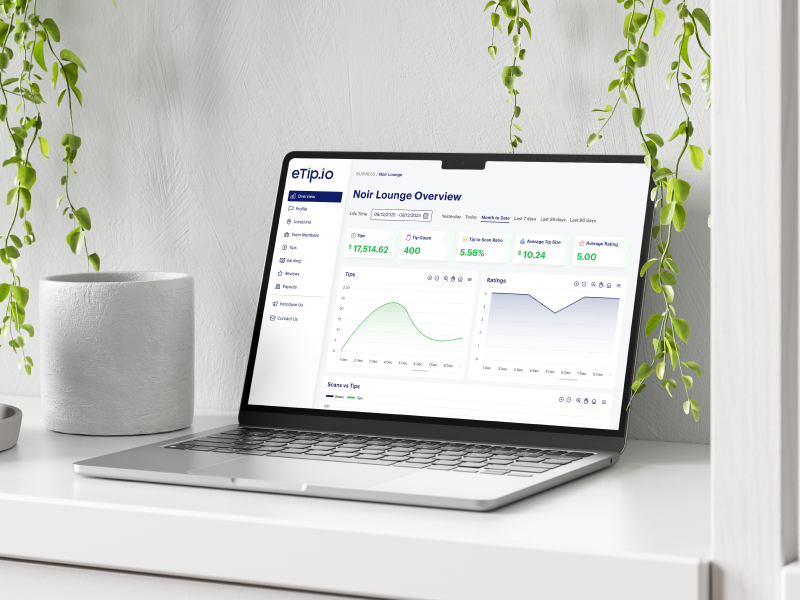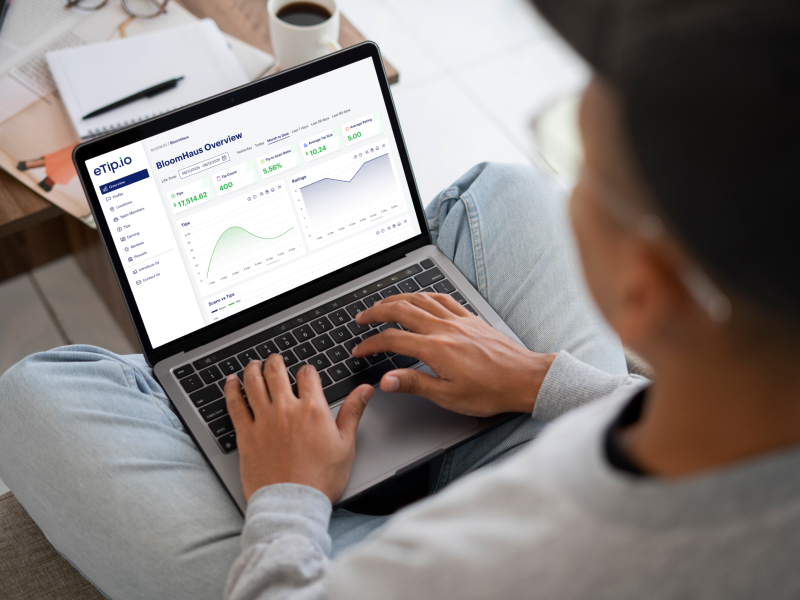Digital Tipping Guide: Why Hospitality and Service Businesses Need a Digital Tipping Solution

Tipping has always been part of the hospitality and service industry’s DNA. But in a world where wallets are digital, spare change is rare, and cashless payments are preferred, the old-school tip jar just isn’t cutting it anymore.
At the same time, hospitality managers and business operators are juggling high employee turnover, rising payroll costs, and the never-ending pursuit of better guest experiences. Needless to say, it’s a lot.
The solution for both consumers and businesses? Digital tipping.
A smarter, faster, and more flexible alternative to cash tips, digital tipping meets guests where they already are — on their phones — and gives your staff the recognition and income they deserve.
In this guide, we’ll unpack what digital tipping really means, how it works, and why hotels, restaurants, and service businesses benefit from moving quickly to adopt it.
Save time and retain employees with the leading digital tipping solution. Learn more.
What is digital tipping?
Digital tipping is the act of sending a gratuity electronically, often via mobile phone. It’s a modern alternative to paying a tip with physical currency.
Tipping has always played an essential role in employee compensation within service and hospitality businesses. But for decades, tipping relied on spare change or crumpled bills — and often excluded behind-the-scenes staff like housekeepers, line cooks, and dishwashers who rarely interacted with guests directly.
These days, fewer customers carry cash, leaving many unsure how or where to leave a tip. As a result, good service goes unrewarded, and staff feel undervalued.
Digital tipping solves that dilemma, providing an instant and effortless way for guests to leave a gratuity. No ATM runs, no awkward conversations, just instant appreciation.
How does digital tipping work?
Digital tipping is a two-part process: accepting the tip and distributing it.

1. Accepting digital tips
- First, a guest leaves a cashless tip, usually by scanning a QR code. Your business can easily print out these QR codes and display them in the lobby, on your menu, or within your service station.
- Scanning the QR code opens a branded tipping page (no app required), where the guest chooses who they want to tip — a team, a department, an individual — and how much.
- Payment takes seconds. With Apple Pay, Google Pay, or credit card options, guests can leave a tip using the same method they use to buy coffee, call an Uber, or book a hotel.
For guests, digital tipping is simple, secure, and fast. For businesses, it captures tips that would otherwise be lost due to a lack of cash on hand.
2. Disbursing digital tips
- Once tips are collected, they’re distributed to employees digitally. This is where tip disbursement software does the heavy lifting.
- At the end of a designated period (whether that’s a shift, a day, or a week), tips are paid out directly to staff instantly or through payroll.
- Managers configure how tips are split: by shift, by percentage, by team, by role, or using custom rules.
The process is fast, fair, and fully traceable — exactly what today’s hospitality and service teams need.
Do digital tips actually go to employees?
Yes, digital tips do go to employees — at least when a digital tipping system is set up properly.
Cashless tips are either routed directly to individual employees or allocated through pre-defined distribution rules.
Businesses can configure:
- How tips are split
- By role, shift, team, or other criteria
- When tips are paid out
- Either instantly or through regular payroll cycles
Pro tip: Make sure any digital tipping software you implement offers clear, auditable records and complies with IRS requirements for tip reporting.

Examples of digital tipping solutions
Digital tipping solutions fall into three categories: digital tipping platforms, pay cards, and digital tip jars. Each takes a different approach to how tips are collected and distributed.
| Digital tipping platforms | Pay cards | Digital tip jars | |
| Primary use case | High-volume businesses (hotels, restaurants, valets, salons) | Teams without traditional bank access | Small businesses, individuals |
| How tips are distributed | Direct to bank account or payroll | Loaded onto prepaid/reloadable debit cards | Split manually or by rule among team |
| Speed of access to tips | Instant or scheduled (daily, weekly, etc.) | Varies — may take days, depending on card provider | Typically paid out after a shift or pay period |
| Scalability | High — suitable for multi-location businesses | Moderate — requires distributing and managing cards | Low — best for individuals or small teams |
| Best for | Businesses seeking full control, automation, and compliance-ready systems | Businesses with unbanked/underbanked staff needing alternative payouts | Individuals or small teams testing digital tipping |
Digital tipping platforms
Digital tip payout platforms are primarily designed to help businesses accept cashless tips and move funds to employees quickly and electronically. These platforms are most commonly used in high-volume service environments like restaurants, bars, salons, and valet companies.
Benefits:
- Employees receive tips quickly (sometimes even instantly), which can improve satisfaction and reduce cash handling.
- Useful for businesses that already track tips through a POS or internal system.
This model works best for businesses that struggle not only with cashless tip collection but with digital disbursement.

Pay cards
Pay cards are like reloadable debit cards issued to employees.
How they work:
- Tips are collected by the business (either digitally or in cash).
- The business or payroll provider loads tips onto each employee’s pay card.
- Employees can then use those cards like debit cards or withdraw funds at ATMs.
Challenges include:
- Most pay cards charge fees
- Pay cards aren’t always accepted by vendors or ATMs
- Transferring funds from pay cards to an employee’s bank account can take several days
Pay cards might be a fit for certain workforce demographics, but they can introduce new layers of complexity — especially if staff turnover is high.
Pro tip: eTip’s debit card is fee-free!
Digital tip jars
Digital tip jars are a simple way to accept tips without cash — usually by displaying a static QR code or link that directs guests to a digital payment page. They’re most popular among small businesses, coffee shops, or individual service providers (like independent stylists, musicians, etc).
How they work:
- A digital tip jar is typically tied to a single department, shift, or individual.
- Guests scan a QR code to leave a tip via Apple Pay, Google Pay, or credit/debit card.
- At the end of a shift or pay period, the total is divided among the group based on a pre-set rule (even split, hours worked, etc.).
Digital tip jars can serve as a low-lift entry point for individuals or small teams just starting to explore contactless tipping. However, they may fall short for businesses seeking detailed tracking or payroll integration.
Benefits of digital tipping for service businesses
Digital tipping does more than just replace cash. It solves some of the most persistent challenges plaguing hospitality and service businesses today.
The right digital tipping system delights employees and helps management without overhauling existing operations.
Here are some of the most impactful benefits of digital tipping for service-driven businesses:
Attract and retain workers
Digital tipping helps staff get paid more, and faster. In an industry with 30%+ turnover, offering real-time, reliable gratuities is a serious competitive edge.
Boost staff retention and morale
Increased tip frequency = higher hourly earnings = happier staff.
Businesses that use eTip’s digital tipping software typically see:
- Up to a 30% increase in staff retention
- Up to $5/hour more in tips per employee
Cut admin time with automation
Manually tracking tips is a time suck for management. Digital tipping platforms automate everything from collection to disbursement to reporting, saving GMs and operators hours every week.
Improve guest experience without lifting a finger
When tipping is effortless, more guests tip. And when teams feel appreciated, they perform better.
That’s a win-win for service scores and online reviews.

Modernize operations
Digital tipping aligns with today’s tech-forward hospitality stack: mobile check-in, digital keys, SMS concierge. It’s a natural next-step for the industry.
Drive revenue and occupancy indirectly
Guests notice when staff go above and beyond. Happier teams deliver better service, which yields stronger reviews. Hotels see higher revPAR, while restaurants can justify higher prices for larger profit margins.
Strengthen brand consistency
Tipping is part of the guest experience — so it should feel like it belongs.
A white-labeled digital tipping app helps reinforce trust and professionalism by matching your company’s look and feel, from colors and logos to messaging. This creates a seamless experience across guest touchpoints and ensures tipping reflects the same level of care as the service itself.
Reduce risk and improve compliance
Handling tips in cash or through manual processes increases the risk of errors, theft, or underreported income.
Digital tipping systems reduce those risks by providing clear records of every transaction and automating tip distribution. Many platforms also support IRS reporting requirements and follow security standards like PCI and SOC 2 compliance, making it easier to stay on top of tax obligations and internal audits.
How to choose a digital tipping solution for your business
Choosing the right digital tipping system means finding a tool that complements your unique operations, supports your staff, and keeps your business compliant.
With multiple platforms and apps on the market, it’s worth slowing down to evaluate the features that matter most to your business.
Here’s what to look for in a digital tipping platform:
- Ease of use
- The system should be intuitive for both guests and staff. If tipping feels clunky or confusing, adoption rates will suffer.
- Look for a platform that’s mobile-friendly and doesn’t require guests or employees to download an app.
- On the backend, managers should be able to configure teams, track performance, and export reports with minimal training.
- Payout flexibility
- Tip disbursement should fit your team’s structure, not the other way around.
- Some businesses prefer instant payouts; others rely on payroll sync. The right platform should support both, with options for splitting tips by role, shift, department, or custom rules.
- Security
- Look for systems that are PCI compliant, SOC 2 certified, and keep a log of every transaction.
- If you’re handling large volumes or implementing the software at multiple locations, cyber insurance and fraud controls are a must.
- Branding
- The tipping experience reflects your brand — make sure it feels that way.
- Choose a system that allows you to white label with your own branding instead of a platform that directs guests to third-party domains with generic branding.
- Integrations
- Consider how well the platform fits into your existing workflows.
- Does it integrate with your payroll, HR, or property management system?
- Can it scale across multiple departments or locations without requiring duplicate setup?
- The more connected the system, the less operational friction you’ll face.
The best digital tipping platform
Chances are you’re not just exploring what digital tipping is — you’re looking for the right solution to implement. And the truth is, not all platforms are built for the complexity of the hospitality and service industry.
eTip is the most customizable digital tipping solution on the market, designed with hotels, restaurants, and service businesses in mind.

With eTip, you get:
- Flexible payout options
Choose between real-time disbursement or payroll sync, with logic that supports teams, roles, shifts, or any custom structure. - Fast, scalable onboarding
Unlike other digital tipping platforms that rely on Stripe and require staff to apply individually, eTip uses its own sponsor bank and FBO account, ensuring every team member gets approved. - Enterprise-grade compliance
SOC 2 Type 2 certification, PCI compliance, and downloadable IRS reports come standard. - Robust integrations
eTip connects with major HR, payroll, and property management systems to reduce admin work and streamline operations across locations. - Full customization
Tailor the tipping experience to match your brand, down to the colors, logos, and guest messaging.
Want to see how eTip works? Schedule a demo and explore what a fully connected digital tipping platform can do for your team.
Join the eTip community!
We'll send the latest content & special releases directly to your inbox.
Ready to join the community?
Receive the latest & greatest content from eTip, sent directly to your preferred inbox!
![[CTA] Image - Retention - 1200 x 627](https://no-cache.hubspot.com/cta/default/6775923/interactive-190476651574.png)
![[CTA] Image - Generic 2 - 1200 x 627](https://no-cache.hubspot.com/cta/default/6775923/interactive-190476979840.png)